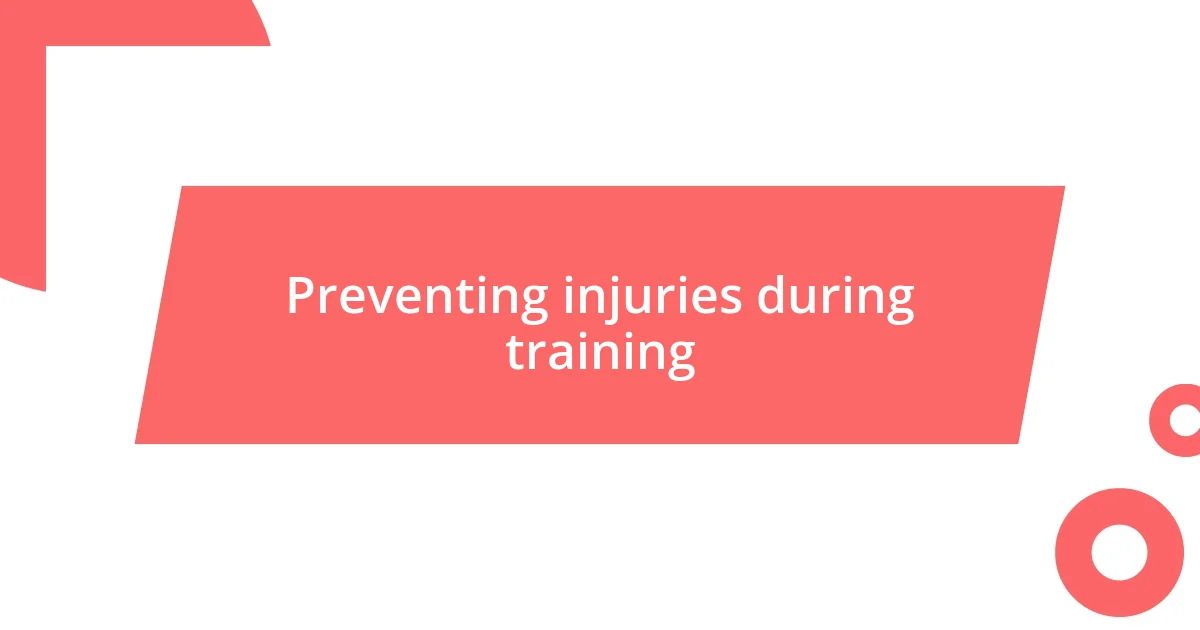Key takeaways:
- Gradually increase mileage and allow for rest to prevent injuries and build strength safely.
- Set achievable goals by assessing your fitness level, breaking them down into smaller milestones, and being flexible.
- Incorporate cross-training, prioritize nutrition and hydration, and listen to your body to enhance performance and prevent injuries.

Understanding marathon training plans
When I first delved into marathon training plans, I was overwhelmed by the sheer amount of information available. I remember poring over different schedules, trying to figure out which plan fit my lifestyle and my running style best. It’s vital to understand that not all plans are created equal; they should align with your current fitness level and running experience.
One key aspect I learned is the importance of gradually increasing your mileage. I vividly recall a week when I ignored this principle and pushed myself too hard, leading to an injury that sidelined my training. Doesn’t the thought of injury keep you up at night when you’re trying to push your limits? The right plan respects your body’s needs, allowing for rest and recovery to ensure you’re building strength safely.
As I navigated various training plans, I discovered that some included speed work, while others focused solely on distance. At first, I was skeptical about incorporating speed workouts. However, once I tried them, I felt an exhilarating surge of energy that made me question whether I had underestimated their value. Have you ever experienced that moment when a new technique takes your performance to another level? Trust me; experimenting within the framework of your training plan can lead to substantial improvements.

Setting achievable marathon goals
Setting achievable marathon goals starts with self-reflection. It’s crucial to gauge your current fitness level and to recognize what you want to accomplish. I recall setting my first goal as simply completing the marathon, and while it felt daunting, breaking it down into bite-sized pieces made it manageable. Embracing that mindset not only motivated me but also helped me stay focused.
Here are some practical tips for setting those goals:
– Assess your fitness level: Be honest about how much you’re currently running.
– Set a clear target: Define whether it’s completing the marathon or beating a personal record.
– Break it down: Divide your main goal into smaller milestones, such as running a 5K or a half marathon first.
– Timelines matter: Establish deadlines for each milestone to keep yourself accountable.
– Be flexible: Allow yourself to adjust your goals as needed based on your progress and experiences.
Celebrating each milestone as I achieved them turned my journey into a joyful experience. Each time I increased my distance, I felt a rush of accomplishment, affirming that I was one step closer to my ultimate goal.

Building a consistent running routine
Building a consistent running routine was one of the most rewarding aspects of my marathon journey. Initially, I struggled to find the motivation to lace up my shoes every day, especially on chilly mornings. But I discovered that consistency didn’t mean always running the same distance. Some days, I would set a timer for just 20 minutes and call it a win, celebrating those shorter sessions as crucial components of my overall training.
I also learned the importance of scheduling my runs as if they were essential meetings. When I began blocking off specific time slots in my calendar, it transformed how I approached running. I remember vividly how excited I felt on my scheduled run days, almost like a kid anticipating a field trip. Just like any other commitment, treating my runs with that level of importance helped solidify my routine, and soon enough, it became a part of my daily life.
Lastly, I found community support incredibly helpful in maintaining consistency. Joining a local running group not only motivated me but also introduced me to incredible friendships. I often look back on those early Saturday morning group runs, where we encouraged each other, shared stories, and celebrated each other’s victories. It made those tough runs far more enjoyable, turning what could have been solitary struggles into a shared journey filled with laughter and camaraderie.
| Aspect | Description |
|---|---|
| Scheduling | Book runs in your calendar to treat them as important commitments. |
| Short Runs | Embrace shorter sessions as valuable contributions to your training. |
| Community | Join running groups to gain motivation and share your experiences. |

Incorporating cross-training activities
Incorporating cross-training activities into my marathon training was a game-changer. I found that cycling, swimming, and even yoga helped to strengthen different muscle groups and prevent burnout. One memorable session was when I swapped a long run for a swim; gliding through the water felt refreshing and surprisingly energizing. Have you ever tried something new and felt invigorated? It reminded me that rest doesn’t always mean doing nothing; it can be an active recovery that enhances my performance.
When I first started cross-training, it felt a bit awkward juggling different activities. But training in the gym with strength workouts added variety to my routine. I vividly recall my first experience with weightlifting – I was nervous, unsure if I was doing it right. Yet with each session, I felt stronger, and my running form benefited from the newfound strength. Isn’t it amazing how cross-training can subtly shift our physical capabilities?
Participating in group cycling sessions was another highlight for me. The energy of riding alongside others pushed me out of my comfort zone, reinforcing the idea that teamwork can never be underestimated. I remember one particularly grueling hills ride where we cheered each other on, and it reminded me that in both running and life, we often succeed better together than alone. Have you ever experienced that support system? It’s one of the simplest yet most profound ways to make training enjoyable and effective.

Nutrition tips for marathon runners
Nutrition plays a pivotal role in my marathon training journey, and I’ve learned that understanding macronutrients is essential. I remember the first time I meticulously tracked my protein, carbs, and fats. It felt a bit overwhelming, but then I realized the impact of consuming the right foods before and after my runs. For instance, a banana with peanut butter became my go-to pre-run snack. It provided just the right amount of energy without weighing me down. What snacks do you reach for before hitting the pavement?
I also found that hydration is often overlooked but is absolutely crucial. During my longer training runs, I started experimenting with electrolyte drinks, and let me tell you, it made a noticeable difference. There was that one day when I forgot to hydrate properly and felt the fatigue hit me hard halfway through a run. It’s humbling to learn the hard way, but now, I make it a point to drink water consistently throughout the day, not just during workouts. Have you ever experienced that dehydrated slump? It’s definitely something I try to avoid at all costs.
Finally, I recognized the value of fueling my body post-run for recovery. I often whip up a smoothie loaded with spinach, berries, and a scoop of protein powder. It’s not just about satisfying hunger, but also about nourishing my muscles to help them repair. I’ve noticed that when I treat recovery meals with the same seriousness as my training, my performance improves significantly. Have you tried focusing on your recovery nutrition? It’s amazing how a little deliberate effort can lead to big results!

Preventing injuries during training
In my marathon training, I quickly realized how essential warm-ups are to prevent injuries. On days I rushed through my stretching routine, I often felt stiffness during my run. It was a wake-up call when I experienced a nagging pain in my knee after skipping my usual warm-up. Now, I always take the time to properly stretch and mobilize my joints, knowing that a few extra minutes can save me from longer recovery times. Have you had a similar experience with rushing into an activity?
Footwear also played a surprising role in my injury prevention journey. I remember my first long run in new sneakers; they felt amazing at first, but by mile eight, my feet were aching. It taught me the importance of not just choosing the right shoes but breaking them in gradually. I make it a point to test new footwear on shorter runs to ensure they provide the support I need. What do you look for in running shoes to keep discomfort at bay?
Lastly, I’ve become a firm believer in listening to my body. There was a time when I pushed through soreness, thinking it was just part of the process. But after one particularly painful run, I learned that ignoring discomfort can lead to bigger problems. Now, if I feel unusual pain, I take a step back, rest, and reassess my training plan. It’s a balance between determination and self-care—what strategies do you use to stay in tune with your body?















